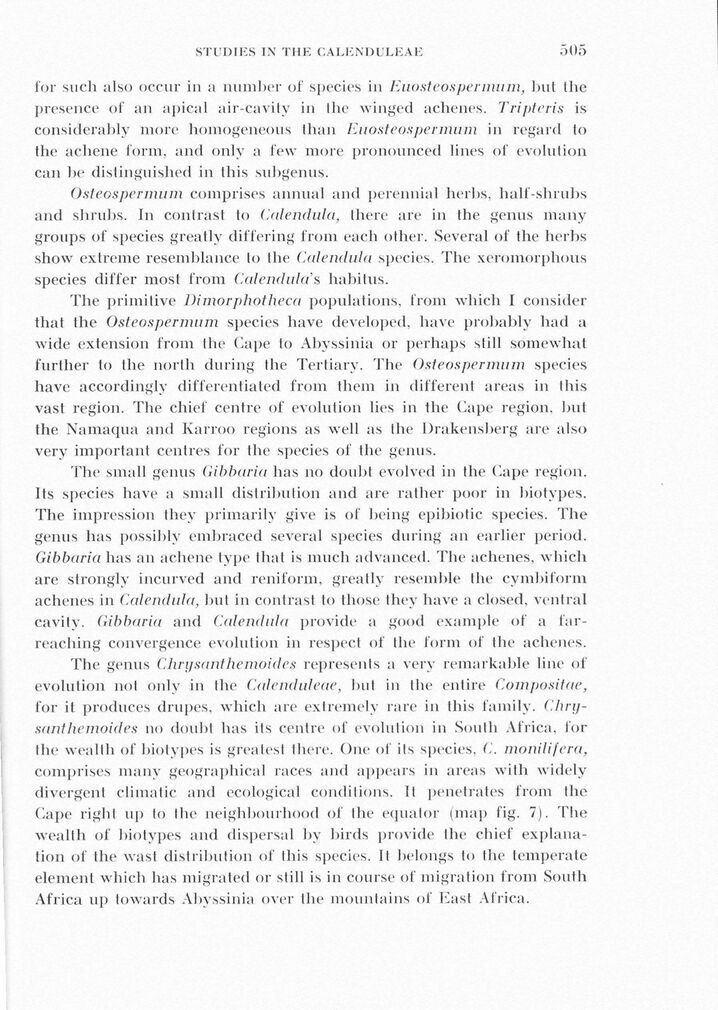
Full resolution (JPEG) - On this page / på denna sida - Sidor ...

<< prev. page << föreg. sida << >> nästa sida >> next page >>
Below is the raw OCR text
from the above scanned image.
Do you see an error? Proofread the page now!
Här nedan syns maskintolkade texten från faksimilbilden ovan.
Ser du något fel? Korrekturläs sidan nu!
This page has never been proofread. / Denna sida har aldrig korrekturlästs.
STUDIES IN THE CALENDULEAE
505
for such also occur in a number of species in Euosteospermum, hut the
presence of an apical air-cavity in Ihe winged achenes. Tripteris is
considerahly möre homogeneous (han Eiiosteospermiim in regard lo
(he achene form, and onlv a lew möre pronoimced lines of evolution
can he distinguished in this suhgenus.
Osteospermum comprises annual and perennial herhs, half-shruhs
and shruhs. In contrast to Calendula, |here are in the genus ma ny
groups of species greatly differing from each other. Several of the herhs
show extreme resemblance lo Ihe Calendula species. The xeromorphous
species differ most from Calendula’s habitus.
The primitive Dimorphotheca populations, from which I consider
that the Osteospermum species have developed, have probably had a
wide extension from Ihe Cape lo Abyssinia or perhaps still somewhat
further to the north during the Tertiary. The Osteospermum species
have accordingly differentiated from them in different areas in this
vast region. The chief centre of evolution lies in the Cape region, hut
the Namaqua and Karroo regions as well as Ihe Drakensberg are also
very important centres for the species of the genus.
The small genus Gibbaria has 110 doubt evolved in the Cape region.
Its species have a small distribution and are rather poor in biotypes.
The impression they primarily give is of being epibiotic species. The
genus has possibly embracecl several speeies during an earlier period.
Gibbaria has an achene type that is much advanced. The achenes, which
are stronglv incurved and reniform, greatly reseinble the cymbif’orm
achenes in Calendula, hut in contrast lo tliose they have a closed, ventral
cavitv. Gibbaria and Calendula provide a good example of a
1’ar-reaching convergence evolution in respect of the form of the achenes.
The genus Clirijsanthemoides represents a verv remarkable line of
evolution nol onlv in the Calenduleae, hut in the entire Compositae,
for il produces drupes, which are exlremely rare in this family.
Clirtjsanthemoides no doubt has its centre of evolution in South Africa, for
the wealth of biotypes is greatesl |here. One of ils species, C. monilifera,
comprises many geographica! races and appears in areas with widely
divergent climatic and ecological condilions. II penetrates from the
Cape right up lo llie neighbourhood of the equator (map fig. 7). The
wealth of biotypes and dispersal bv birds provide the chief
explana-tion of the wast distribution of this species. Il belongs lo the temperate
element which has migrated or slill is in course of migration from South
Africa up towards Abyssinia over the mounlains of East Africa.
<< prev. page << föreg. sida << >> nästa sida >> next page >>